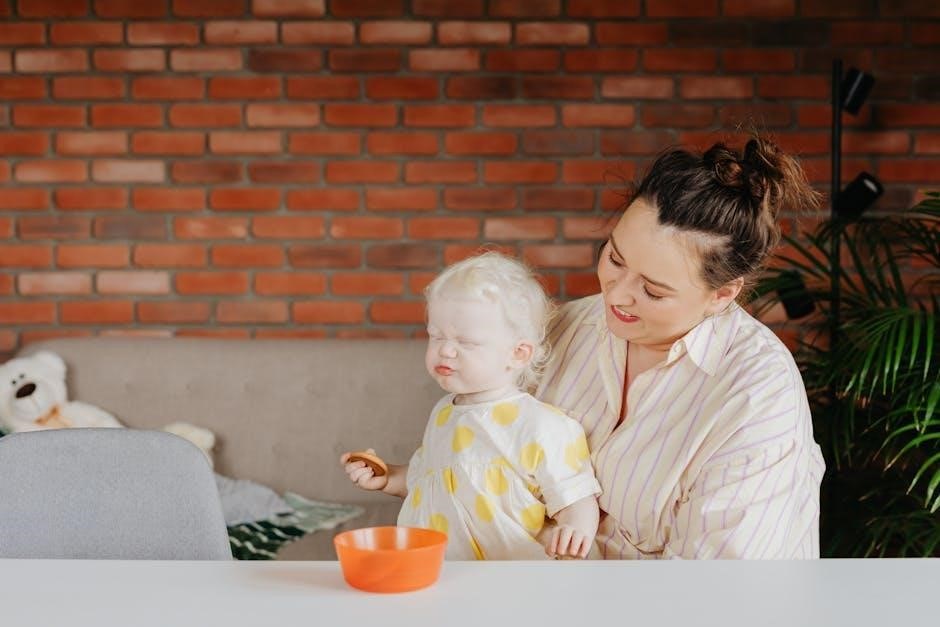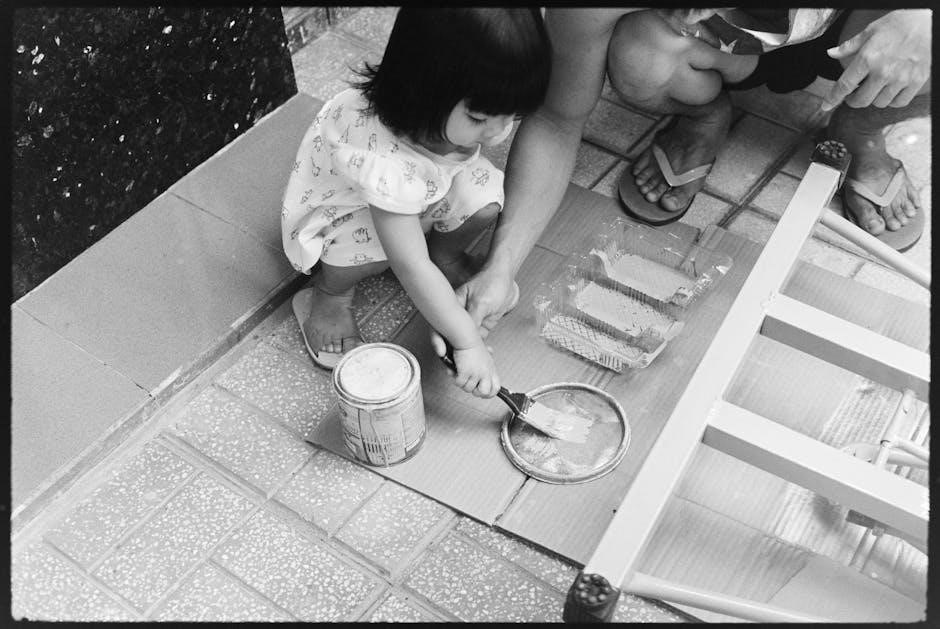Initiating the Conversation About Downsizing
Start by gently discussing the benefits of downsizing‚ such as reduced maintenance and costs‚ while respecting their feelings and involving family for emotional support.
1.1. How to Approach the Topic Sensitively
Approach the conversation with empathy‚ acknowledging the emotional attachment to the family home. Involve family members for support and emphasize the practical benefits of downsizing‚ such as reduced maintenance and financial relief. Listen actively to their concerns and involve them in decision-making to ensure they feel in control of the process.
1.2. Understanding Emotional Attachments to the Family Home
Recognize that the family home holds memories and sentimental value‚ making downsizing emotionally challenging. Every item‚ from furniture to trinkets‚ may evoke cherished moments. Acknowledge these feelings and approach the topic with respect and patience. Involve your parents in decision-making to help them feel in control and valued‚ ensuring they understand the practical benefits while honoring their emotional connections.

Assessing the Current Living Situation
Evaluate the home’s layout‚ storage‚ and functionality to identify unused spaces and prioritize needs. This step helps create a clear plan for downsizing and organizing.
2.1. Evaluating the Space and Needs
Assess the current living space to identify unused areas and prioritize essential items. Consider future needs‚ such as accessibility and storage‚ to create a practical plan. Measure rooms and furniture to ensure a smooth transition. Involve family in discussions to align expectations and make decisions that balance comfort with practicality.
2.2. Creating an Inventory of Belongings
Begin by categorizing items into keep‚ donate‚ sell‚ or discard. This process helps clarify what is truly essential. Involve family members to share memories and make decisions together. Use a list or digital tool to track belongings‚ ensuring everything is accounted for. This step aids in decision-making and preserves cherished memories while simplifying the downsizing process.

Decision-Making Factors for Downsizing
When considering downsizing‚ assess reasons‚ compare living options‚ and evaluate financial and emotional impacts to make informed decisions;
3.1. Identifying the Reasons for Downsizing
Understanding the motivations behind downsizing is crucial. Common reasons include reducing maintenance burdens‚ cutting costs‚ or adapting to lifestyle changes. Others may downsize for health reasons or a desire to live closer to family. It’s essential to align the decision with personal goals and ensure it aligns with their future needs and preferences.
3.2. Comparing Options for Senior Living
When exploring senior living options‚ consider independent living‚ assisted living‚ or memory care communities. Evaluate factors like location‚ amenities‚ and cost. Think about proximity to family and healthcare services. Assessing the level of care needed and budget constraints is essential. Visiting communities and speaking with residents can provide valuable insights. Professional guidance can also help align choices with lifestyle preferences.

Involving Family and Professional Help
Engage family members for emotional support and practical assistance. Consider hiring professional organizers or estate specialists to streamline the downsizing process and ensure a smooth transition.
4.1. Recruiting Support from Family Members
Involve family members by assigning tasks based on their strengths‚ such as organizing belongings or researching new living options. Open communication helps ensure everyone’s concerns are heard. Encourage siblings to share responsibilities and provide emotional support. Having a united front eases the transition and reduces feelings of overwhelm for your parents.
- Assign tasks to family members based on their strengths.
- Encourage open communication to address concerns.
- Share responsibilities to ease the emotional burden.
4.2. Hiring Professional Organizers or Estate Specialists
Consider hiring professional organizers or estate specialists to streamline the downsizing process. They can help organize belongings‚ manage estate sales‚ and provide practical solutions. Their expertise reduces stress and ensures a smooth transition. Professionals can also assist in evaluating sentimental items and creating a plan that honors memories while decluttering.
- Expertise in organizing and estate management.
- Stress reduction for both parents and family.
- Practical solutions for sentimental and practical items.

Sorting and Decluttering Strategies
Begin by categorizing items into keep‚ donate‚ sell‚ or discard. Focus on practical needs and emotional value‚ ensuring each decision aligns with the new space.
- Room-by-room approach for clarity.
- Family involvement for shared decisions.
- Sentimental items handled with care.
5.1. Practical Tips for Decluttering Room by Room
Begin with one room at a time‚ starting with areas like the attic or garage. Use boxes labeled “keep‚” “donate‚” or “discard.” Handle sentimental items gently‚ involving family in decisions. Focus on essentials and organize remaining items neatly. Celebrate progress to keep motivation high throughout the process.
5.2. Handling Heirlooms and Sentimental Items
Approach heirlooms with empathy‚ understanding their emotional value. Consider photographing items or creating a memory box to preserve memories without keeping everything. Involve family in decisions to ensure shared agreement. Offer to pass items to younger generations or donate to meaningful causes‚ honoring their legacy while simplifying the space.

Financial Considerations and Planning
Calculate moving costs‚ new living expenses‚ and potential savings from downsizing. Budgeting and understanding tax implications can help ensure financial stability and peace of mind.
6.1; Budgeting for the Move and New Living Arrangements
Budgeting is crucial for a smooth transition. Calculate moving costs‚ new living expenses‚ and storage fees. Consider one-time expenses like furniture and setup. Plan for recurring costs such as utilities and maintenance. Consult financial advisors to optimize resources. Prioritize needs over wants to avoid overspending. A detailed budget ensures financial stability and reduces stress during the downsizing process.
6.2. Understanding the Cost Benefits of Downsizing
Downsizing offers significant cost savings‚ including lower utility bills‚ reduced maintenance expenses‚ and potential income from selling unused items. Smaller spaces often mean lower property taxes and insurance costs. Additionally‚ downsizing can free up capital‚ providing financial flexibility for future needs or investments. These benefits make downsizing a practical choice for enhancing financial stability and peace of mind in retirement.

Emotional and Psychological Challenges
Downsizing can evoke feelings of loss and anxiety‚ especially when leaving a long-time family home. Emotional attachments to memories and belongings often make decision-making difficult. Creating memory boxes can help preserve cherished moments while letting go of physical items.
7.1. Coping with Loss and Change
Recognize that downsizing can evoke grief and nostalgia. Validate their feelings and celebrate memories together. Encourage open conversations and seek support from family or professionals if needed. Acknowledge the emotional weight of letting go‚ while gently highlighting the opportunities for a simpler‚ more manageable lifestyle. Allow time to process these changes‚ ensuring they feel heard and understood throughout the transition.
7.2. Celebrating Memories While Moving Forward
Celebrate cherished memories by creating a memory box or scrapbook with meaningful items. Share stories and reflect on the past with loved ones. Focus on the positive aspects of downsizing‚ such as a simpler lifestyle and new opportunities. Honor the past while embracing the future‚ ensuring the transition feels meaningful and empowering for your parents.
Logistics of the Move
Plan the move by creating a timeline‚ packing strategically‚ and organizing belongings. Consider hiring professionals for heavy items and label boxes clearly for easy unpacking.
8.1. Planning the Move and Packing Strategically
Create a detailed plan with timelines and tasks‚ ensuring a smooth transition. Use practical packing tips‚ such as labeling boxes clearly and prioritizing essentials. Develop a checklist for utilities‚ paperwork‚ and final cleanups. Involve family or professionals to streamline the process and reduce stress. Focus on organizing belongings efficiently to make unpacking easier in the new space.
8.2. Unpacking and Setting Up the New Space
Unpacking should focus on organizing essentials first‚ ensuring comfort and accessibility. Arrange furniture to create a familiar and functional layout. Personalize the space with cherished items to maintain a sense of home. Involve family or professionals to assist with heavy tasks and ensure safety. Prioritize creating a peaceful environment that supports independence and fosters a sense of normalcy in the new setting.

Maintaining Independence and Lifestyle
Downsizing can enhance independence by simplifying living arrangements and reducing responsibilities‚ allowing seniors to focus on hobbies and social connections while maintaining their personal routines and freedom.
9.1. Adapting to a Smaller Living Environment
Adapting to a smaller space requires minimizing clutter and prioritizing essentials. Focus on efficient layouts and multi-functional furniture to maximize comfort. Encourage your parents to embrace the simplicity of downsizing‚ highlighting how it simplifies maintenance and daily life. Creating a cozy‚ well-organized environment can help them feel at home and ease the transition to a more manageable lifestyle.
9.2. Staying Connected to Family and Community
Help your parents stay connected by scheduling regular family visits and encouraging participation in community activities. Technology‚ such as video calls‚ can bridge distances and maintain relationships. Joining local clubs or groups aligns interests and fosters new friendships. Emphasize that downsizing doesn’t mean isolating—staying engaged enhances their emotional well-being and sense of belonging in their new environment.
Downsizing is an emotional journey‚ but with careful planning and support‚ it can lead to a simpler‚ more fulfilling life. Celebrate memories while embracing the future with confidence.
10.1. Reflecting on the Downsizing Journey
Reflecting on the downsizing journey allows families to celebrate memories while acknowledging the challenges overcome. It’s a moment to cherish the emotional connections to belongings and spaces‚ even as new beginnings unfold. This reflection helps in honoring the past while embracing a simpler‚ more fulfilling life ahead.
10.2. Embracing the Future with Confidence
Embracing the future with confidence involves focusing on the positive aspects of downsizing‚ such as reduced responsibilities and the freedom to explore new experiences. Staying connected to family and community ensures a sense of belonging‚ while celebrating past memories allows for a smooth transition. This journey fosters personal growth and a renewed sense of purpose‚ helping seniors and their families welcome the next chapter with optimism.

No Responses